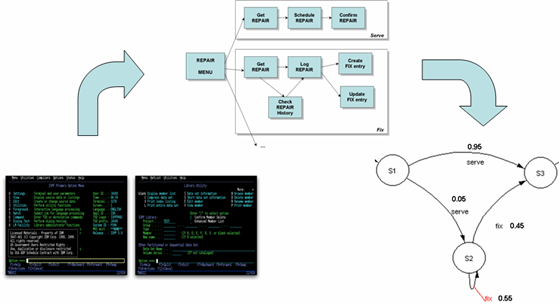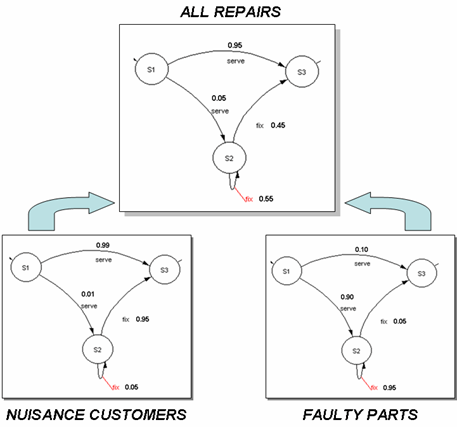Business process discovery
Business process discovery (BPD) related to business process management and process mining is a set of techniques that manually or automatically construct a representation of an organisations' current business processes and its major process variations. These techniques use evidence found in the existing organisational methods of work, documentations, and technology systems that run business processes within an organization.
Business process discovery techniques
Business process discovery techniques embody the following properties:
- Emergent paradigm - Current methods are based on top-down structured manual interviews relying on second-hand representations of the business process/system behaviors. An automated discovery process relies on collecting data from the information system over a period of time. This data can then be analyzed to form a process model.
- Automated process discovery – By automating the analysis of the data, the subjectivity of current manual process analysis techniques is removed. The automated system has an ingrained methodology that — through repeated trials — has been shown to accurately discover processes and process variations without bias.
- Accurate information- Since the information is collected from the actual source it cannot be inaccurate, as opposed to gathering it from second party representation.
- Complete information - An automated process captures all the information that is occurring within the system and represents them by time, date, user, etc.... Since the information is collected from real-time interactions, it is not subject to lost or selective memory issues. This includes completeness regarding exceptions in the processes. Often, exceptions are treated as statistical “noise,” which may exclude important inefficiencies in business processes.
- Standardized Process - The automated collection of information yields process data which can be grouped, quantified and classified. This supplies a basis for the development and monitoring of both current and new processes, to which benchmarks can be assigned. These benchmarks are the root of both new process design and the determination of problem root cause. Additionally, standardized process data can set the stage for efforts at continuous process improvement.
Application / techniques
Business Process Discovery complements and builds upon the work in many other fields.
- Process discovery is one of the three main types of process mining. The other two types of process mining are conformance checking and model extension/enhancement.[1] All of these techniques aim at extracting process related knowledge from event logs. In the case of process discovery, there is no prior process model; the model is discovered based on event logs. Conformance checking aims at finding differences between a given process model and event log. This way it is possible to quantify compliance and analyze discrepancies. Enhancement takes an a priori model and improves or extends it using information from the event log, e.g., show bottlenecks.
- Business process discovery is the next level of understanding in the emerging field of business analytics, which allows organizations to view, analyze and adjust the underlying structure and processes that go into day-to-day operations. This discovery includes information gathering of all of the components of a business process, including technology, people, department procedures and protocols.
- Business process discovery creates a process master which complements business process analysis (BPA). BPA tools and methodologies are well suited to top-down hierarchical process decomposition, and analysis of to-be processes. BPD provides a bottoms-up analysis that marries to the top-down to provide a complete business process, organized hierarchically by BPA.
- Business Intelligence provides organizations with reporting and analytics on the data in their organizations. However, BI has no process model, awareness or analytics. BPD complements BI by providing an explicit process view to current operations, and providing analytics on that process model to help organizations identify and act upon business process inefficiencies, or anomalies.
- Web analytics are a limited example of BPD in that web analytics reconstruct the web-user’s process as they interact with a Web-site. However, these analytics are limited to the process as is contained within the session, from the users perspective and with respect to just the web-based system and process.
- Business triage provides a framework for categorizing the processes identified by business process analysis (BPA) based on their relative importance to achieving a stated, measurable goal or outcome. Utilizing the same categories employed by military medical and disaster medical services, business processes are categorized as:
- Essential/critical (red process) - Process essential for achieving outcomes/goals
- Important/urgent (yellow process) - Process which speeds achieving outcomes/goals
- Optional/supportive (green process) - Process not needed to achieve outcomes/goals
Resources are allocated based on the process category with resources first dedicated to red processes, then yellow processes and finally green processes. In the event that resources become limited, resources are first withheld from Green Processes, then Yellow Processes. Resources are only withheld from Red Processes if failure to achieve outcomes/goals is acceptable.
The purpose / example
A small example may illustrate the Business Process Discovery technology that is required today. Automated Business Process Discovery tools capture the required data, and transform it into a structured dataset for the actual diagnosis; A major challenge is the grouping of repetitive actions from the users into meaningful events. Next, these Business process discovery tools propose probabilistic process models. Probabilistic behavior is essential for the analysis and the diagnosis of the processes. The following shows an example where a probabilistic repair-process is recovered from user actions. The “as-is” process model shows exactly where the pain is in this business. Five percent faulty repairs is a bad sign, but worse, the repetitive fixes that are needed to complete those repairs are cumbersome.

A deeper analysis of the “as-is” process data may reveal which are the faulty parts that are responsible for the overall behavior in this example. It may lead to the discovery of subgroups of repairs that actually need management focus for improvement.

In this case, it would become obvious that the faulty parts are also responsible for the repetitive fixes. Similar applications have been documented, such as a Healthcare Insurance Provider case where in 4 months the ROI of Business Process Analysis was earned from precisely comprehending its claims handling process and discovering the faulty parts.
History
- Business intelligence (BI) emerged more than 20 years ago and is critical for reporting what is happening within an organization’s systems. Yet current BI applications and data mining technologies are not always suited for evaluating the level of detail required to analyze unstructured data and the human dynamics of business processes.
- Six-Sigma and other quantitative approaches to business process improvement have been employed for over a decade with varying degrees of success. A major limitation to the success of these approaches is the availability of accurate data to form the basis of the analysis. With BPD, many six-sigma organizations are finding the ability to extend their analysis into major business processes effectively.
- Process mining According to researchers at Eindhoven University of Technology, (PM) emerged as a scientific discipline around 1990 when techniques like the Alpha algorithm made it possible to extract process models (typically represented as Petri nets) from event logs. Criticisms have emerged pointing out that Process Mining is no more than a set of algorithms which solves a specific and simple business problem: business process discovery and auxiliary evaluation methods. Today, there are over 100 process mining algorithms that are able to discover process models that also include concurrency, e.g., genetic process discovery techniques, heuristic mining algorithms, region-based mining algorithms, and fuzzy mining algorithms.
References
Further reading
- W.M.P. van der Aalst, “Process Mining: Discovery, Conformance and Enhancement of Business Processes”. Springer Verlag, Berlin, 2011 (ISBN 978-3-642-19344-6).
- Cook J. E., Wolf A. L., “Automating Process Discovery through Event-Data Analysis”, Proceedings of the 17th International Conference on Software Engineering, Seattle, Washington, USA, 1995.
- Irani Z., Hlupic V., Giaglis G., “Business-Process Reengineering: A Design Perspective”, The International Journal of Flexible Manufacturing Systems, 12, pp. 247 – 252 (2000)
- Linton, J. D., “Facing the Challenges of Service Automation: An enabler for E-Commerce and Productivity Gain in Traditional Services”, IEE transactions on Engineering Management, 54, No. 4, November, 2003.
- Linton, J., “Process Mapping and Design: A detailed process map can help reduce everything from cycle time to defects to process steps”, Circuits Assembly: The Journal for Surface Mount and Electronics Assembly, February 2007
- Verner, L., “The Challenge of Process Discovery”, BPM Trends, May 2004.
- W.M.P. van der Aalst, B.F. van Dongen, J. Herbst, L. Maruster, G. Schimm, and A.J.M.M. Weijters. Workflow Mining: A Survey of Issues and Approaches. Data and Knowledge Engineering, 47(2):237-267, 2003.
- W.M.P. van der Aalst, A.J.M.M. Weijters, and L. Maruster. Workflow Mining: Discovering Process Models from Event Logs. IEEE Transactions on Knowledge and Data Engineering, 16(9):1128-1142, 2004.
- W.M.P. van der Aalst, H.A. Reijers, A.J.M.M. Weijters, B.F. van Dongen, A.K. Alves de Medeiros, M. Song, and H.M.W. Verbeek. Business Process Mining: An Industrial Application. Information Systems, 32(5):713-732, 2007.